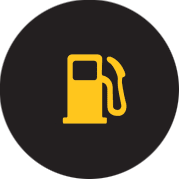Just because your Lexus is a luxury car doesn’t mean it’s going to magically fix itself when something goes wrong. So, if you see any of those pesky little warning lights pop up on your dashboard, don’t ignore them!
Your car is trying to tell you something important, and you don’t want to end up with a fancy paperweight instead of a luxury vehicle. These warning lights are designed to alert you to potential problems with your vehicle, and ignoring them could lead to serious issues down the line.
Fun Fact:
Did you know that the Lexus logo is designed to create a sense of simplicity and elegance? The logo is a combination of the letters L, E, and X arranged in a unique way to create a sleek and modern look.
The oval shape around the logo is meant to represent the steering wheel of a car, while the silver color symbolizes sophistication and innovation.
Categorizing based on color
1. Red Warning Lights
Red warning lights in Lexus or any other brand are typically used to indicate a serious problem or a safety issue that requires immediate attention.
When a red warning light comes on, it is crucial to address the issue promptly and seek assistance or professional help to avoid potential damage or accidents.
Examples
- Open door warning light
- Low Engine oil pressure light
- Battery warning light
- Brake system warning light
- High car temperature light
- Parking brake warning light
- Seatbelt warning light
- SRS warning light
- Hood open warning light
- Power steering system warning
2. Yellow/Amber Warning Lights
Yellow or amber warning lights generally indicate a non-critical issue or a component that needs attention but may not require immediate action.
It is advisable to have the cause of a yellow warning light investigated and resolved in a timely manner to prevent further damage or potential failures.
Examples:
- Check engine light (indicating a potential engine issue)
- Tire pressure monitoring system (TPMS) light
- ABS (anti-lock braking system) warning light.
- Low fuel level light
- Traction control off warning light
- Slip indicator light
- Blind spot indicator
- Lane departure indicator
- Vehicle stability off indicator
3. Blue & White Informational Lights
Blue lights are usually informational or indicate that a specific system or feature is activated.
Examples:
- High-beam headlight indicators.
- Sports mode indicator
- Auto glide control indicator
- Gear shift indicator
These lights are generally not caused for immediate concern, but it’s essential to be aware of their meaning for proper operation and safety.
4. Green Informational Lights
- Green lights are typically used to convey information about vehicle systems or operations.
- Examples of green lights include:
- Turn signal indicator. (when the turn signal is active)
- Exterior light indicator.
- Eco mode indicator
- Cruise control indicator
- Crawl control indicator (for SUV)
- Easy access control indicator (for SUV)
- EV mode indicator
- Lane departure warning indicator.
Green lights generally signify that a particular system is functioning correctly or that a specific action is taking place. It’s important to note that the specific meanings of warning lights can vary slightly between different car models and manufacturers.
The dashboard warning lights mentioned above are strictly for LEXUS car models. They may defer slightly depending on the car’s model.
Categorizing based on being common:

Below are some of the most common warning lights that you may see on your Lexus, along with their meanings:
| Warning light | Purpose |
|---|---|
|
Check Engine Light
|
This warning light signifies that there is a problem with your vehicle’s engine or emissions system. It is important to have your vehicle checked by a mechanic as soon as possible to prevent any further damage to your engine. |
Seatbelt Warning Light |
The seat belt reminder light or buzzer warns the driver to fasten their seat belt. To turn off the warning light and/or buzzer, the driver must fasten their seat belt. |
Low Fuel Level Warning Light |
It is important to refuel as soon as possible to prevent running out of gas while driving. Running out of gas can cause damage to your engine and can be dangerous if you are on a busy road or highway. |
Open Door Warning Light |
Check all of the doors on your vehicle to ensure that they are properly closed and locked. If the light remains on, there may be a problem with your vehicle’s door sensors. Have your vehicle checked by a mechanic. |
Oil Pressure Warning Light |
This warning light indicates that your vehicle’s oil pressure is low, which can lead to engine damage if not addressed promptly. Stop your vehicle and check your oil level. If it is low, add more oil. If the light remains on, take your vehicle to a mechanic. |
Battery Warning Light |
This warning light indicates that your vehicle’s battery is not charging properly. It can be caused by a faulty alternator or battery. Have your vehicle checked by a mechanic as soon as possible to prevent any further damage. |
Tire Pressure Warning Light |
This warning light indicates that your tire pressure is low. Check your tire pressure and inflate your tires to the recommended level. If the light remains on, there may be a problem with your tire pressure monitoring system. Have your vehicle checked by a mechanic. |
| Brake System Warning Light
|
This warning light indicates that there is a problem with your vehicle’s braking system. It can be caused by low brake fluid levels, worn brake pads, or a malfunctioning brake system. Have your vehicle checked by a mechanic as soon as possible for your safety. |
In Short
It is important to remember that these warning lights are designed to protect your vehicle and keep you safe on the road.
If you see any of these warning lights appear on your dashboard, take action immediately to prevent any further damage to your vehicle.

A part-time Motor enthusiast & a full-time dad!







